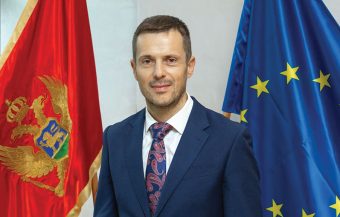I n a crucial period of energy transition, Montenegro has a clear goal: moving towards energy sources that are more sustainable and less harmful to the environment. This transition is a response to international obligations related to climate change and a key part of the national strategy to improve energy efficiency and environmental protection. We spoke with Saša Mujović, Montenegro’s Minister of Energy, about ratifying international agreements, adopting new laws, and implementing major infrastructure projects, as well as Montenegro’s commitment to achieving ambitious goals.
Q: How is Montenegro’s energy transition progressing?

A: By ratifying international climate change agreements, Montenegro has committed to taking measures to implement the energy transition. The energy sector is recognized as the area that contributes the most to greenhouse gas emissions and is expected to play a significant role in stabilizing pollutant concentrations. The most important activities for reaching these goals include adopting the Law on the Use of Energy from Renewable Sources, which will accelerate the integration of solar and wind-based production facilities. We have also announced subsidies for various energy efficiency programs. Participants in these programs will directly reduce air pollution while achieving financial savings. As for EPCG (Electric Power Company of Montenegro), one of the pillars of energy development in Montenegro, they can boast of responsible and regular maintenance of production facilities. Two long-awaited projects stand out – the ecological reconstruction of the thermal power plant and the heating system project in Pljevlja.
Q: What does the Law on the Use of Energy from Renewable Sources bring? How much is being invested in renewable energy in Montenegro, and is the distribution and transmission network ready for new capacities?
A: The Law on the Use of Energy from Renewable Sources transposes the provisions of the EU’s RED II Directive and provides a legal framework for promoting renewable energy. It will help Montenegro improve its incentive environment and achieve its goals for the share of renewable energy in total final energy consumption by 2030. One of the key provisions of this law is the introduction of auctions for allocating state incentives in the form of market premiums. This will gradually phase out feed-in tariffs and strengthen competition in the wholesale electricity market.
IN FOCUS:
- Sustainability Starts on the Roof
- Energy Transition In Serbia – Challenges and Potential
- How Energy Efficiency Shapes the Future of Serbia
More importantly, this law will also establish the legal basis for creating renewable energy communities, an innovative model that will further value solar panel installation projects on rooftops and allow citizens to benefit financially from the energy transition process.
Montenegro has significant natural potential for developing renewable sources, which attracts great interest from investors. We have signed contracts for approximately 1.5 GW of production capacity through transmission system connection agreements, mainly from solar power plants. Currently, the network cannot meet all investor demands; however, system operators are working intensively on strengthening the energy infrastructure so that it does not become a limiting factor for constructing new production facilities. Additionally, alternative solutions are being prepared to bridge the infrastructure gaps and allow the continued development of new power plants. We expect the development of the energy network to progress in parallel with the construction of new facilities, as outlined in the new Law on the Use of Energy from Renewable Sources.
Q: Why is the ecological reconstruction of the Pljevlja Thermal Power Plant important? How long will this reconstruction extend the plant’s operational life?
A: The ecological reconstruction of the thermal power plant is an extremely important project for Pljevlja and Montenegro. It aims to adapt the plant’s operations to meet the state’s environmental protection commitments. Upon completion of the project, the plant is expected to be fully operational with limited emissions of nitrogen, sulfur, and particulate matter in compliance with the EU Large Combustion Plants Directive. This is one of the prerequisites for extending the plant’s operational life, which is a pillar of stability for the country’s energy system and provides about 40 percent of Montenegro’s domestic electricity production.
Regarding the plant’s future operations, it is almost certain that it will continue to operate for another 10 years after the reconstruction is complete. The complete phase-out of coal-powered production will depend on the pace of developing alternative sources, which will provide adequate substitutes for the missing energy.
Interview by Milica Radičević
Read the whole interview in the new issue of the Energy portal Magazine ENERGY TRANSITION

